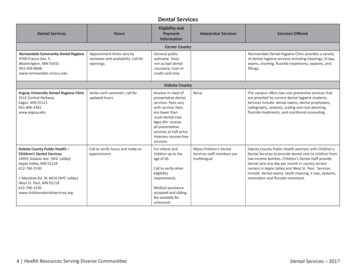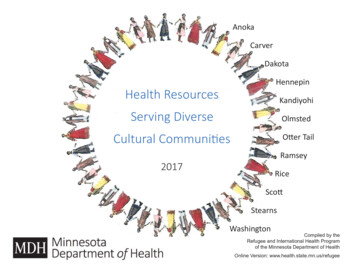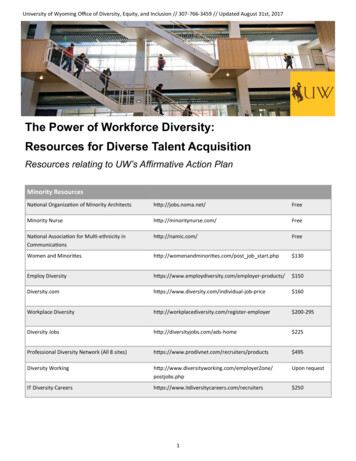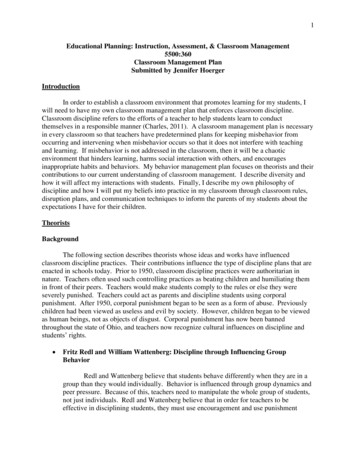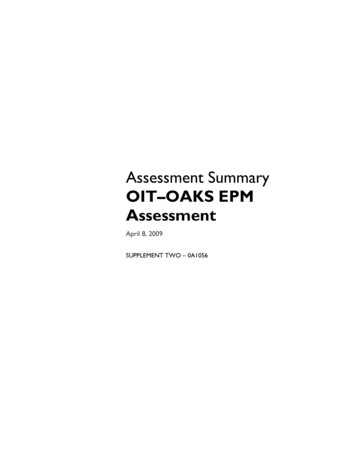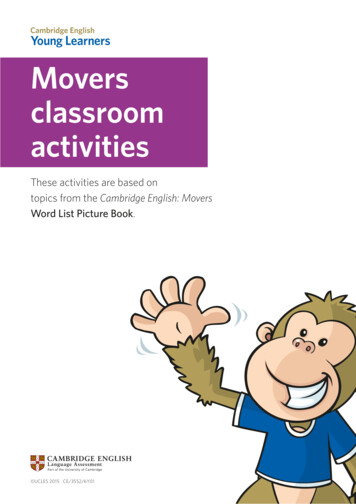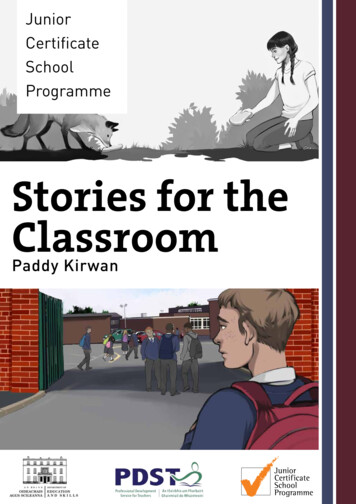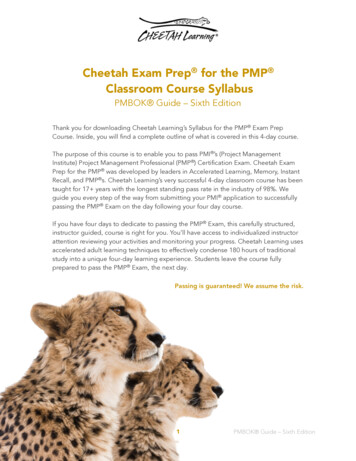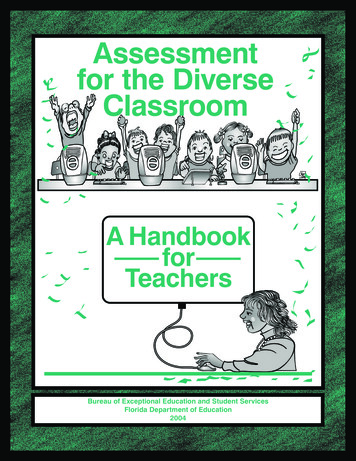
Transcription
Assessmentfor the DiverseClassroomA HandbookforTeachersBureau of Exceptional Education and Student ServicesFlorida Department of Education2004
This is one of the many publications available through the Bureau of Exceptional Educationand Student Services, Florida Department of Education, designed to assist school districts,state agencies which support educational programs, and parents in the provision of specialprograms. For additional information on this publication, or for a list of available publications,contact the Clearinghouse Information Center, Room 628 Turlington Building, Tallahassee,Florida 32399-0400.telephone: (850) 245-0475FAX: (850) 245-0953Suncom: 205-0475email: BRIC@fl.doe.orgwebsite: http://www.myfloridaeducation.com/commhome/
Assessment for the Diverse Classroom A Handbook for Teachers Bureau of Exceptional Education and Student Services Florida Department of Education 2004
This product was developed by the Accommodations and Modifications for Students withDisabilities Project through the Learning Systems Institute, Florida State University, fundedby the State of Florida, Department of Education, Bureau of Exceptional Education andStudent Services, through federal assistance under the Individuals with Disabilities EducationAct (IDEA), Part B.Florida Department of EducationBureau of Exceptional Education and Student ServicesMichele Polland, Acting ChiefEvy Friend, Administrator, ESE Program Development and ServicesIris Palazesi, Supervisor, ESE Program Development and ServicesLezlie Cline, Supervisor, ESE Program Development and ServicesCopyrightState of FloridaDepartment of State2004Authorization for reproduction is hereby granted to the State System of Public Educationconsistent with Section 1006.39 (2), Florida Statutes. No authorization is granted fordistribution or reproduction outside the State System of Public Education without priorapproval in writing.
Assessment for the Diverse Classroom A Handbook for Teachers byJan Thomas, Ph.D.Carol Allman, Ph.D.Marty Beech, Ph.D.Accommodations and Modifications for Students with Disabilities ProjectLearning Systems Institute Florida State University
Acknowledgements The authors would like to express sincere thanks to the individuals who participated in theformative evaluation and expert review of this document. Their input and suggestions were criticalto the development of the document.Formative Evaluation ParticipantsCheryl Bennett-Lee, Wakulla Middle School, Crawfordville, FloridaPat Berrigan, Rickards High School, Tallahassee, FloridaAnnette Carpenter, Nims Middle School, Tallahassee, FloridaSuzanne Edwards, Wakulla Middle School, Crawfordville, FloridaElizabeth Farmer, Gretchen Everhart ESE Center School, Tallahassee, FloridaPatricia Gavin, Fairview Middle School, Tallahassee, FloridaElaine Harrison, Griffin Middle School, Tallahassee, FloridaCathy Howard, Crawfordville Elementary School, Crawfordville, FloridaJeri Jump, Wakulla Middle School, Crawfordville, FloridaKristin Large, Raa Middle School, Tallahassee, FloridaJanice McLaughlin, Rickards High School, Tallahassee, FloridaBobbye McNish, Leon County Schools, Tallahassee, FloridaCamille Park, FLDRS Miccosukee Associate Center, Tallahassee, FloridaTerry Price, Wakulla Middle School, Crawfordville, FloridaKim Scott, Shadeville Elementary School, Crawfordville, FloridaJenny Taylor, Godby High School, Tallahassee, FloridaNan Whitley, Leon High School, Tallahassee, FloridaExpert Review ParticipantsLara Jakobson, Learning Systems Institute, Florida State University, Tallahassee, FloridaBeth O’Donnell, Wakulla County Schools, Crawfordville, Florida
Table of Contents Chapter 1—What Does “Assessment” Mean? .1 What Is “Assessment”?. 2 Types of Assessment . 2 Standardized Tests . 3 Commercially Prepared Assessments. 4 Teacher-Made Assessments. 5 Phases of Assessment. 5 Phase One: Pre-Assessment . 5 Phase Two: Ongoing Assessment . 7 Phase Three: Final Assessment. 12 Comparing the Three Phases of Assessment . 14 Benefits of Assessment . 15 Benefits for Teachers. 15 Benefits for Students . 15 Summary . 16 Chapter 2——Types of Classroom AssessmentAssessments. 17 Selected Response Items . 18 Alternate Response . 19 Multiple Choice . 23 Matching . 27 Constructed Response Items . 29 Short Answer and Sentence Completion . 29 Essay . 33 Performance Assessment . 38 Summary . 44 Chapter 3—Assessment Accommodations .45 What Are Accommodations? . 46 Who Is Eligible to Receive Accommodations?. 47 Types of Accommodations . 48 Presentation. 48 Response. 50 Schedule. 51 Setting. 52 Assistive Technology . 52 Evaluating the Effects of Accommodations . 53 Summary . 53 vi
Table of Contents (Continued)Chapter 4—Planning for Classroom Assessment .55 Selecting Assessments . 56 Step One–Identify Instructional Goals. 56 Step Two–Design the Lesson . 58 Step Three–Determine Evidence of Learning. 60 Summary . 62 Chapter 5—Using Classroom Assessment Data.63 Using Assessment Data for Students. 65 Monitoring Student Progress . 65 Identifying Patterns of Strengths and Weaknesses. 66 Providing Feedback. 68 Using Assessment Data for Improving Instruction. 70 Step One: Review Data from Each Assessment . 71 Step Two: Review Overall Results. 73 Step Three: Consider Outside Factors . 74 Step Four: Develop an Action Plan . 75 Using Assessment Data with Administrators . 76 Identifying Curriculum Weaknesses . 76 Identifying Students Needing Academic Intervention . 76 Showing Improvement in Student Performance Based on Professional Development . 77 Summary . 77 Resources. 79 vii
Chapter 1 What Does “Assessment” Mean? As a teacher, you make decisions every day about how to present theinformation you want your students to learn and how to find out if theyare learning. The process you use to make these decisions consists of threecomponents—what content you teach (the curriculum), how the content istaught (the instruction), and how you measure what thestudents actually learn (the assessment). Each of thesecurriculumcomponents plays a critical role, and the process is weakenedwhen one of them is missing or inadequately addressed.This book focuses on the assessments you design to gatherdata about how well your students are learning. Because thethree components are so entwined, frequent references toassessmentinstructionboth curriculum and instruction are an integral part of thediscussion.1
Assessment for the Diverse ClassroomWhat Is “Assessment”? Many people think that assessment is limited to the paper and penciltests given in class to see if students have learned the content. Assessmentis far more than pencil and paper tests. You are using a form of assessmenteach time you observe your students in the classroom; look at products andperformances; or talk with teachers, parents, or students about the progressthe students are making. Assessment involves anything you do to gatherinformation to make decisions about your students’ learning and yourteaching.The primary purpose of assessment is togather information, or data. Data is simplyDATA is informationyou use as a basis forinformation you use as a basis for decisiondecision-making. Youmaking. There are many forms of data,gather data throughincluding test scores, anecdotal notes, responsesassessment to let youto questionnaires, and ratings. The data fromand your students knowpaper and pencil tests can give you informationthe quality and depth oflearning that is takingsuch as how many spelling words a student hasplace.learned, whether a student can solve certainkinds of mathematics problems, or if the studentknows facts about a specific period in history.Performance assessments can provide you with data about a student’sability to synthesize information, present information, and make inferences.Observations can also give you data about a student’s preferred learning style,how well the student works in groups, and how much time a student needs tobe given to complete an assignment. The purpose of assessment is to let youand the student know about the quality and depth of learning that is takingplace.Types of Assessment AssessmentAssessment is a general term that includesmany different ways to collect, analyze, andinterpret data. In general, the three types ofassessment most commonly used by teachers forthe purpose of learning about student progressare standardized tests, commercially preparedassessments, and teacher-made assessments.2ASSESSMENT is ageneral term used todescribe the process ofcollecting, analyzing,and interpretinginformation (data) for anintended purpose.Airasian, 1996
Chapter 1 What Does Assessment Mean?Standardized Tests A standardized test, according to Popham (1999), anexpert in testing and evaluation, is “a test, either normreferenced or criterion-referenced, that is administered,scored, and interpreted in a standard manner” (p. 264).Norm-referenced means that your students’ performanceon the test can be compared to the performance of othersimilar students who have taken the same test (the “norm”group). The information gained from this type of test isintended to help teachers and parents know how theirstudents are doing in comparison to other similar students.A NORMREFERENCED TESTcompares a student’sperformance on aparticular test to theperformance of othersimilar students whohave taken the sametest.A criterion-referenced test, on the other hand, looks ata student’s performance in relation to mastery of certain specified content.On this type of test, a decision is made about what constitutes proficiency, oradequate learning of the content. A passing score is established that representsmastery. If a student scores at or above the passing score,it is assumed that he or she is competent or proficient inA CRITERIONknowledge of the specified content.REFERENCED TESTevaluates a student’sperformance in relationto mastery of certainspecified content.Many states, Florida included, have developedstandardized tests to measure the achievement of theirstudents. The consequences for individual student failuremay be high; the student may not be promoted to the nextgrade or may not be allowed to graduate with a standarddiploma. The stakes for schools are also high, with publicrankings and the rewarding or withholding of funds attached to the scoresand ranks. The implications for teachers are obvious. These tests guide thecurriculum you teach and the way your students are taught and tested. Muchcontroversy surrounds the issue of whether or not teachers should coach theirstudents (“teach to the test”) or if this is considered cheating. The issues box onthe next page compares coaching and cheating.You want your students to do well on all assessments they encounter inschool and in life. If learning is the reason students attend school, and ifassessment is the way you find out if they are learning, it only makes goodsense to give students every ethical opportunity to demonstrate their learning.You have a responsibility to help your students prepare for whatever life hasto offer them, and that responsibility includes preparing them to succeed onassessments.3
Assessment for the Diverse ClassroomTeaching to the Test:A Comparison of Coaching and CheatingISSUESCoaching (Ethical)Cheating (Unethical)Teaching content and skills coveredon the testDeveloping a curriculum basedsolely on test contentTraining students in test-taking skillsPreparing and teaching objectivesbased solely on the testChecking answer sheets for propercompletionUsing actual or unauthorized testitems for student worksheetsIncreasing student motivation onthe test through appeals to parents,students, and teachersUsing artificial score-raisingprogramsProviding practice in handling avariety of item types (multiple choice,short answer, essay)Excluding low-achieving studentsfrom taking the testfrom Ward and Murray-Ward, 1999, p.25Commercially Prepared AssessmentsMany of the textbooks and supplemental materials you use for instructionin your classroom are commercially prepared and include assessments.These assessments may be used in a number of ways, including screening,diagnosing learning problems, monitoring progress, and evaluating learneroutcomes related to a specific instructional program. Instructional materialsoften include assessments designed for units of instruction or lessons. It isimportant to be sure that these tests truly assess the content you are teaching.You must also make sure there is a match between these assessments and theexpectations of the Sunshine State Standards. When this is not the case, youmay need to adapt them or develop your own.4
Chapter 1 What Does Assessment Mean?Teacher-Made Assessments When you develop your own classroom assessments, it is important to besure that the tests are at the right level of difficulty for your students in terms ofthe content being assessed and the way the content is presented. Commerciallyprepared materials are designed for a targeted student ability level and may betoo easy or too difficult for your particular students. When you develop yourown assessments, you can make sure that the content you are expecting yourstudents to learn is exactly what you are assessing. You can also make surethat the assessments are written at the correct reading level for your students.Chapter four guides you through the process of determining which type ofassessment item (for example, multiple choice or essay) to choose.Phases of Assessment Classroom assessment requires an ongoing process to determine if studentshave learned the concepts and skills that have been presented in class. In orderto get the whole picture of a student’s learning, you should include three phasesof assessment during the course of a year or semester: pre-assessment, ongoingassessment, and final assessment. In this section we will examine each of thesephases of assessment to determine what it is, what it is used for, and what typesof assessments are included in each phase.Phase One: Pre-Assessment What is pre-assessment?Pre-assessment is a systematic assessment that occurs atthe beginning of a school year or when starting a new unitof instruction to determine your students’ level of knowledgeor skill about the subject. Pre-assessment activities mayinclude tests or they may simply be conversations with yourstudents. Pre-assessment can even occur before a studentbegins the school year, such as the preschool screening usedwith students entering kindergarten.5PRE-ASSESSMENTis a systematicassessment that occursat the beginning of aschool year or whenstarting a new unit ofinstruction. It helpsyou make decisionsabout what instructionalactivities are appropriatefor your students sothat you can begininstruction at a properplace and level.
Assessment for the Diverse ClassroomWhat is the purpose of pre-assessment?Pre-assessment can be used in various ways. One way is as a diagnostictool to help determine at what level a particular student is functioning. Youcan also use pre-assessment to help you make decisions about what kinds ofinstructional activities are appropriate for the students you have in a particularclass. It is good to determine early in the year what skills and knowledgestudents have so that you can begin your instruction at an appropriate level. Ifstudents have the prerequisite skills and knowledge for the instruction you haveplanned, a brief review may be all that is needed. However, if prerequisiteskills and knowledge are missing or weak, reteaching may be necessary. Youcan also use pre-assessment to help you determine your instructional goals fora particular unit. Use the pre-assessment checklist to get the information youneed.CHECKLISTPre-assessmentDo the students have the prerequisite skills and knowledgethey need in order to be able to benefit from the instructionI have planned?YesNoDo I need to reteach or review some of the information orskills?YesNoAre the instructional goals for the unit appropriatefor my students?YesNoWhat pre-assessment techniques should I use?There are different techniques you can use to conduct a pre-assessment.You can look at your students’ past achievements by talking with teachers whohave had them in previous years or by reviewing students’ cumulative folders.You can use a pretest on the information you plan to cover in a given unitor have students self-report what they know. Some commercially preparedinstructional materials include two forms for each test. One form of
on the test Deve op ng a curr cu um based so y on test content Train ng students n test-tak ng sk Prepar ng and teach ng ob ect ves based so y on the test Check ng answer sheets for proper comp on Us ng actua or unauthor zed test tems for student worksheets Increas ng student mot vat on

